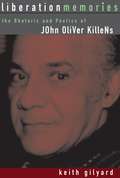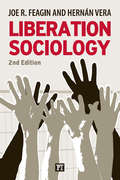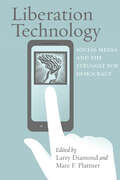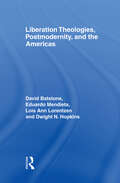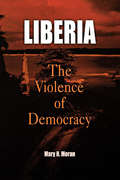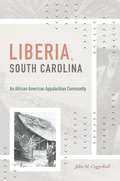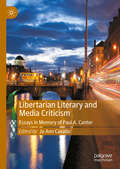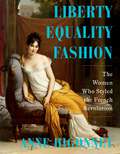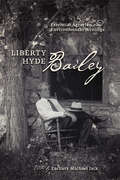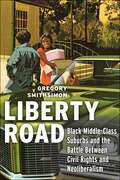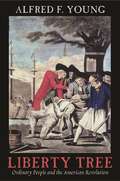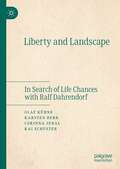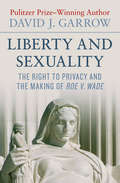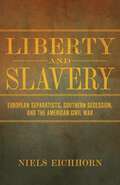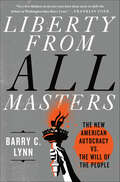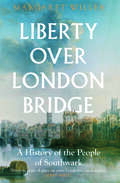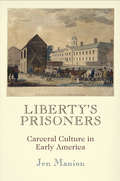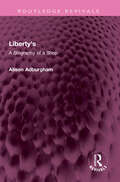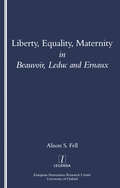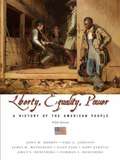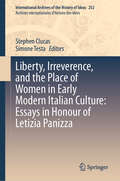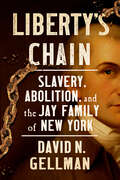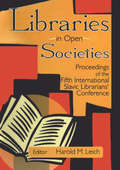- Table View
- List View
Liberation Memories: The Rhetoric and Poetics of John Oliver Killens
by Keith GilyardNo serious history of the development of the African American novel from the 1950s onward can be written without reference to John Oliver Killens. A two-time nominee for the Pulitzer Prize and founding chairman of the legendary Harlem Writers Guild, Killens was regarded by many as a spiritual father who inspired a generation of African American novelists with his politically charged works. And yet today he rarely receives proper critical attention. Seeking to strengthen our understanding of this important literary figure, Keith Gilyard departs from standard critical frameworks to reveal Killens's novels as artful renderings of rich African American rhetorical forms and verbal traditions. Gilyard finds that many critics, adhering to ideals of art for art's sake or narrative conciseness, are ill-equipped to appreciate the many ways in which Killens's fiction succeeds. Rejecting the "pure art" position, Killens sought to articulate Black heroism particularly within a family or community context, offering a set of values he deemed liberatory. He focused on rendering noble and polemical characters, and his work represents a distinguished fusion of sociopolitical persuasion (rhetoric) and literary artifact (poetics). To help illuminate such novels as Youngblood (1954), And Then We Heard the Thunder (1962), and The Cotillion (1971), Gilyard examines Killens's work as an essayist and cultural organizer, highlighting his activism. His life and literary production can be partly characterized, Gilyard suggests, by the African American jeremiad--a major rhetorical form in the Black intellectual tradition expressing faith that America's destiny is to become an authentic, pluralistic democracy.
Liberation Sociology
by Joe R. Feagin Hernan VeraLiberation sociology is concerned with eliminating social oppressions and creating truly just societies. Liberation sociology takes sides with the oppressed and envisions an end to that oppression. Liberation social scientists featured in this book consciously try to step outside their groups or societies and view them critically. The authors examine theories and research of social scientists who ask, Social science for what purpose? and Social science for whom? Case studies offer humanistic, democratic, and activist answers. Featured researchers provide tools to increase human abilities to understand deep social realities, engage in better dialogues, and increase democratic participation in use of knowledge.Many people of all ages today continue to be attracted to sociology and other social sciences because of their promise to contribute to better political, social, and moral understandings of themselves and their social worlds-and often because they hope it will help them to build a better society. We accent the liberation potential of social science with these social science teachers and students firmly in mind.
Liberation Technology: Social Media and the Struggle for Democracy (A Journal of Democracy Book)
by Larry Diamond and Marc F. PlattnerThe revolutions sweeping the Middle East provide dramatic evidence of the role that technology plays in mobilizing citizen protest and upending seemingly invulnerable authoritarian regimes. A grainy cell phone video of a Tunisian street vendor’s self-immolation helped spark the massive protests that toppled longtime ruler Zine El Abidine Ben Ali, and Egypt’s "Facebook revolution" forced the ruling regime out of power and into exile. While such "liberation technology" has been instrumental in freeing Egypt and Tunisia, other cases—such as China and Iran—demonstrate that it can be deployed just as effectively by authoritarian regimes seeking to control the Internet, stifle protest, and target dissenters. This two-sided dynamic has set off an intense technological race between "netizens" demanding freedom and authoritarians determined to retain their grip on power.Liberation Technology brings together cutting-edge scholarship from scholars and practitioners at the forefront of this burgeoning field of study. An introductory section defines the debate with a foundational piece on liberation technology and is then followed by essays discussing the popular dichotomy of "liberation" versus "control" with regard to the Internet and the sociopolitical dimensions of such controls. Additional chapters delve into the cases of individual countries: China, Egypt, Iran, and Tunisia.This book also includes in-depth analysis of specific technologies such as Ushahidi—a platform developed to document human-rights abuses in the wake of Kenya’s 2007 elections—and alkasir—a tool that has been used widely throughout the Middle East to circumvent cyber-censorship.Liberation Technology will prove an essential resource for all students seeking to understand the intersection of information and communications technology and the global struggle for democracy.Contributors: Walid Al-Saqaf, Daniel Calingaert, Ronald Deibert, Larry Diamond, Elham Gheytanchi, Philip N. Howard, Muzammil M. Hussain, Rebecca MacKinnon, Patrick Meier, Evgeny Morozov, Xiao Qiang, Rafal Rohozinski, Mehdi Yahyanejad
Liberation Theologies, Postmodernity and the Americas
by David Batstone Eduardo Mendieta Dwight N. Hopkins Lois Ann LorentzeFirst Published in 1997. Routledge is an imprint of Taylor & Francis, an informa company.
Liberazione Della Donna: Feminism in Italy
by Lucia C. BirnbaumA survey of the history and modern transformation of the Italian feminist movement.
Liberia
by Mary H. MoranLiberia, a small West African country that has been wracked by violence and civil war since 1989, seems a paradoxical place in which to examine questions of democracy and popular participation. Yet Liberia is also the oldest republic in Africa, having become independent in 1847 after colonization by an American philanthropic organization as a refuge for "Free People of Color" from the United States. Many analysts have attributed the violent upheaval and state collapse Liberia experienced in the 1980s and 1990s to a lack of democratic institutions and long-standing patterns of autocracy, secrecy, and lack of transparency. Liberia: The Violence of Democracy is a response, from an anthropological perspective, to the literature on neopatrimonialism in Africa.Mary H. Moran argues that democracy is not a foreign import into Africa but that essential aspects of what we in the West consider democratic values are part of the indigenous African traditions of legitimacy and political process. In the case of Liberia, these democratic traditions include institutionalized checks and balances operating at the local level that allow for the voices of structural subordinates (women and younger men) to be heard and be effective in making claims. Moran maintains that the violence and state collapse that have beset Liberia and the surrounding region in the past two decades cannot be attributed to ancient tribal hatreds or neopatrimonial leaders who are simply a modern version of traditional chiefs. Rather, democracy and violence are intersecting themes in Liberian history that have manifested themselves in numerous contexts over the years.Moran challenges many assumptions about Africa as a continent and speaks in an impassioned voice about the meanings of democracy and violence within Liberia.
Liberia, South Carolina: An African American Appalachian Community (H. Eugene and Lillian Youngs Lehman Series)
by John M. CoggeshallIn 2007, while researching mountain culture in upstate South Carolina, anthropologist John M. Coggeshall stumbled upon the small community of Liberia in the Blue Ridge foothills. There he met Mable Owens Clarke and her family, the remaining members of a small African American community still living on land obtained immediately after the Civil War. This intimate history tells the story of five generations of the Owens family and their friends and neighbors, chronicling their struggles through slavery, Reconstruction, the Jim Crow era, and the desegregation of the state. Through hours of interviews with Mable and her relatives, as well as friends and neighbors, Coggeshall presents an ethnographic history that allows members of a largely ignored community to speak and record their own history for the first time. This story sheds new light on the African American experience in Appalachia, and in it Coggeshall documents the community's 150-year history of resistance to white oppression, while offering a new way to understand the symbolic relationship between residents and the land they occupy, tying together family, memory, and narratives to explain this connection.
Libertarian Literary and Media Criticism: Essays in Memory of Paul A. Cantor
by Jo Ann CavalloThis volume applies libertarian philosophy and free-market economic theory to both literature and media, from early modern drama to novels to comic books, cinema, and television series. Several chapters contrast capitalism with statism, focusing on the market economy versus central planning, freedom versus government coercion. Not surprisingly, the economic theories of Adam Smith, Ludwig von Mises, and F.A. Hayek run through several essays. Contributors also engage with other theorists and writers as diverse as Thomas Hobbes, Charles Darwin, Thomas Huxley, Friedrich Nietzsche, Leo Strauss, and Judith Butler.
Liberty Equality Fashion: The Women Who Styled the French Revolution
by Anne HigonnetThree women led a fashion revolution and turned themselves into international style celebrities. Joséphine Bonaparte, future Empress of France; Térézia Tallien, the most beautiful woman in Europe; and Juliette Récamier, muse of intellectuals, had nothing left to lose. After surviving incarceration and forced incestuous marriage during the worst violence of the French Revolution of 1789, they dared sartorial revolt. Together, Joséphine and Térézia shed the underwear cages and massive, rigid garments that women had been obliged to wear for centuries. They slipped into light, mobile dresses, cropped their hair short, wrapped themselves in shawls, and championed the handbag. Juliette made the new style stand for individual liberty. The erotic audacity of these fashion revolutionaries conquered Europe, starting with Napoleon. Everywhere a fashion magazine could reach, women imitated the news coming from Paris. It was the fastest and most total change in clothing history. Two centuries ahead of its time, it was rolled back after only a decade by misogynist rumors of obscene extravagance. New evidence allows the real fashion revolution to be told. This is a story for our time: of a revolution that demanded universal human rights, of self-creation, of women empowering each other, and of transcendent glamor
Liberty Hyde Bailey: Essential Agrarian and Environmental Writings
by Liberty Hyde Bailey"Nature-study not only educates, but it educates nature-ward; and nature is ever our companion, whether we will or no. Even though we are determined to shut ourselves in an office, nature sends her messengers. The light, the dark, the moon, the cloud, the rain, the wind, the falling leaf, the fly, the bouquet, the bird, the cockroach-they are all ours. If one is to be happy, he must be in sympathy with common things. He must live in harmony with his environment. One cannot be happy yonder nor tomorrow: he is happy here and now, or never. Our stock of knowledge of common things should be great. Few of us can travel. We must know the things at home."—from "The Meaning of the Nature-study Movement""To feel that one is a useful and cooperating part in nature is to give one kinship, and to open the mind to the great resources and the high enthusiasms. Here arise the fundamental common relations. Here arise also the great emotions and conceptions of sublimity and grandeur, of majesty and awe, the uplift of vast desires—when one contemplates the earth and the universe and desires to take them into the soul and to express oneself in their terms; and here also the responsible practices of life take root."—from The Holy EarthBefore Wendell Berry and Aldo Leopold, there was the horticulturalist and botanist Liberty Hyde Bailey (1858–1954). For Wendell Berry, Bailey was a revelation, a symbol of the nature-minded agrarianism Berry himself popularized. For Aldo Leopold, Bailey offered a model of the scholar-essayist-naturalist. In his revolutionary work of eco-theology, The Holy Earth, Bailey challenged the anthropomorphism—the people-centeredness—of a vulnerable world. A trained scientist writing in the lyrical tradition of Emerson, Burroughs, and Muir, Bailey offered the twentieth century its first exquisitely interdisciplinary biocentric worldview; this Michigan farmer's son defined the intellectual and spiritual foundations of what would become the environmental movement.For nearly a half century, Bailey dominated matters agricultural, environmental, and scientific in the United States. He worked both to improve the lives of rural folk and to preserve the land from which they earned their livelihood. Along the way, he popularized nature study in U.S. classrooms, lobbied successfully for women's rights on and off the farm, and bulwarked Teddy Roosevelt's pioneering conservationism.Here for the first time is an anthology of Bailey's most important writings suitable for the general and scholarly reader alike. Carefully selected and annotated by Zachary Michael Jack, this book offers a comprehensive introduction to Bailey's celebrated and revolutionary thinking on the urgent environmental, agrarian, educational, and ecospiritual dilemmas of his day and our own. Culled from ten of Bailey's most influential works, these lyrical selections highlight Bailey's contributions to the nature-study and the Country Life movements. Published on the one-hundredth anniversary of Bailey's groundbreaking report on behalf of the Country Life Commission, Liberty Hyde Bailey: Essential Agrarian and Environmental Writings will inspire a new generation of nature writers, environmentalists, and those who share with Bailey a profound understanding of the elegance and power of the natural world and humanity's place within it.
Liberty Road: Black Middle-Class Suburbs and the Battle Between Civil Rights and Neoliberalism
by Gregory SmithsimonA unique insight into desegregation in the suburbs and how racial inequality persists Half of Black Americans who live in the one hundred largest metropolitan areas are now living in suburbs, not cities. In Liberty Road, Gregory Smithsimon shows us how this happened, and why it matters, unearthing the hidden role that suburbs played in establishing the Black middle-class. Focusing on Liberty Road, a Black middle-class suburb of Baltimore, Smithsimon tells the remarkable story of how residents broke the color barrier, against all odds, in the face of racial discrimination, tensions with suburban whites and urban Blacks, and economic crises like the mortgage meltdown of 2008. Drawing on interviews, census data, and archival research he shows us the unique strategies that suburban Black residents in Liberty Road employed, creating a blueprint for other Black middle-class suburbs. Smithsimon re-orients our perspective on race relations in American life to consider the lived experiences and lessons of those who broke the color barrier in unexpected places. Liberty Road shows us that if we want to understand Black America in the twenty-first century, we must look not just to our cities, but to our suburbs as well.
Liberty Tree: Ordinary People and the American Revolution
by Alfred F YoungThe renowned historian offers a &“subtle, complex, and bold&” reassessment of the American Revolution in this acclaimed essay collection (Howard Zinn, author of A People&’s History of the United States). In Liberty Tree, Alfred F. Young presents a selection of his seminal writing as well as two provocative, never-before-published essays. Together, they take the reader on a journey through the American Revolution, exploring the role played by ordinary women and men (called, at the time, people out of doors) in shaping events during and after the Revolution, their impact on the Founding generation of the new American nation, and finally how this populist side of the Revolution has fared in public memory. Drawing on a wide range of sources, which include not only written documents but also material items like powder horns, and public rituals like parades and tarring and featherings, Young places ordinary Americans at the center of the Revolution. Moreover, Young interrogates standard historical narratives through close examination of Revolutionary icons, such as the pamphleteer Thomas Paine and Boston's Freedom Trail. For decades, Young's path-breaking work has shed light on ordinary people of the Revolutionary era, seamlessly blending sophisticated analysis with compelling prose. From his award-winning work on mechanics, or artisans, in the seaboard cities of the Northeast to the all but forgotten liberty tree, a major popular icon of the Revolution explored in depth for the first time, Young continues to astound readers as he forges new directions in the history of the American Revolution.
Liberty and Landscape: In Search of Life Chances with Ralf Dahrendorf
by Olaf Kühne Corinna Jenal Karsten Berr Kai SchusterThis book explores the importance of freedom and liberalism in the context of socialities, individualities and materialities. The authors provide a highly unusual and innovative blending of concepts about space and landscape through a deeply theoretical exploration of liberalism.Liberalism is often problematized in contemporary discussions with regard to gentrification, environmental problems and inequality. In contrast, this book refers to a liberalism that maximizes life chances in the context of dealing with spaces. A connection between freedom and space, based on liberal ideas, provides a much needed theoretical intervention in the fields of social and spatial sciences.
Liberty and Sexuality: The Right to Privacy and the Making of Roe v. Wade
by David J. GarrowPulitzer Prize-winning author David J. Garrow's stirring and essential history of the politics of abortion and America's battle for the right to choose In 1973, the Supreme Court handed down its landmark Roe v. Wade decision legalizing abortion, and more than forty years later the issue continues to spark controversy and divisiveness. But behind this historic legal case lie the battles women fought to establish their rights to use contraceptives and choose to have an abortion. Liberty and Sexuality traces these political and legal struggles in the decades leading up to Roe v. Wade--including the momentous 1965 Supreme Court ruling in Griswold v. Connecticut that established a constitutional "right to privacy." Garrow personalizes the struggles by detailing the vital contributions made by dozens of crusaders who tirelessly paved the way. This expansive and substantial work also addresses the threats to sexual privacy and the legality of abortion that have risen since Roe v. Wade. With abortion still a contentious subject on the national political landscape, Liberty and Sexuality is not just a historical account of the right to choose, but an indispensable read about preserving a freedom that continues to divide America.
Liberty and Slavery: European Separatists, Southern Secession, and the American Civil War (Conflicting Worlds: New Dimensions of the American Civil War)
by Niels EichhornIn Liberty and Slavery, Niels Eichhorn examines the language of slavery, which he considers central to revolutionary struggles, especially those waged in Europe in the nineteenth century. Eichhorn begins in 1830 with separatist movements in Greece, Belgium, and Poland, which laid the foundation for rebellions undertaken later in the century, and then shifts focus to the 1848 uprisings in Ireland, Hungary, and Schleswig-Holstein. He argues that revolutionaries embraced or rejected the language of slavery as they saw fit, using it to justify their rebellions and larger goals. The failure of these insurgencies propelled a wave of revolutionary migrants across the Atlantic world. Those who journeyed to the United States felt the need to adjust to the political and sectional divisions in their new home. Eichhorn shows that separatism was widespread during this period; the secessionist aims of the American Confederacy were by no means unique. Additionally, Eichhorn explores these migrants’ motivations for shunning the Confederacy during the American Civil War. Having been steeped in the language of slavery and separatism, they naturally sided with the Union when the sectional crisis culminated in civil war in 1861.
Liberty from All Masters: The New American Autocracy vs. the Will of the People
by Barry C. LynnBarry C. Lynn, one of America's preeminent thinkers, provides the clearest statement yet on the nature and magnitude of the political and economic dangers posed by America’s new monopolies in Liberty from All Masters."Very few thinkers in recent years have done more to shift the debate in Washington than Barry Lynn."—Franklin Foer Americans are obsessed with liberty, mad about liberty. On any day, we can tune into arguments about how much liberty we need to buy a gun or get an abortion, to marry who we want or adopt the gender we feel. We argue endlessly about liberty from regulation and observation by the state, and proudly rebel against the tyranny of course syllabi and Pandora playlists. Redesign the penny today and the motto would read “You ain’t the boss of me.”Yet Americans are only now awakening to what is perhaps the gravest domestic threat to our liberties in a century—in the form of an extreme and fast-growing concentration of economic power. Monopolists today control almost every corner of the American economy. The result is not only lower wages and higher prices, hence a concentration of wealth and power in the hands of the few. The result is also a stripping away of our liberty to work how and where we want, to launch and grow the businesses we want, to create the communities and families and lives we want. The rise of online monopolists such as Google and Amazon—designed to gather our most intimate secrets and use them to manipulate our personal and group actions—is making the problem only far worse fast. Not only have these giant corporations captured the ability to manage how we share news and ideas with one another, they increasingly enjoy the power to shape how we move and play and speak and think.
Liberty over London Bridge: A History of the People of Southwark
by Margaret WillesThe first complete history of Southwark, London&’s stubbornly independent community over the Thames Southwark&’s fortunes have always been tied to those of the City of London across the river. But from its founding in Roman times through to flourishing in the medieval era, the Borough has always fiercely asserted its independence. A place of licence, largely free of the City&’s jurisdiction, Southwark became a constant thorn in London&’s side: an administrative anachronism, a commercial rival, and an asylum for undesirable industries and residents. In this remarkable history of London&’s liberty beyond the bridge, Margaret Willes narrates the life and times of the people of Southwark, capturing the Borough&’s anarchic spirit of revelry. Populated by a potent mix of talented immigrants, religious dissenters, theatrical folk, brewers, and sex workers, Southwark often escaped urban jurisdiction—giving it an atmosphere of danger, misrule, and artistic freedom. Tracing Southwark&’s history from its Roman foundation to its present popularity as a place to visit, through Chaucer, to Shakespeare, and on to Dickens, Willes offers an indispensable exploration of the City&’s unacknowledged mirror image.
Liberty's Dawn: A People's History of the Industrial Revolution
by Emma Griffin&“Emma Griffin gives a new and powerful voice to the men and women whose blood and sweat greased the wheels of the Industrial Revolution&” (Tim Hitchcock, author of Down and Out in Eighteenth-Century London). This &“provocative study&” looks at hundreds of autobiographies penned between 1760 and 1900 to offer an intimate firsthand account of how the Industrial Revolution was experienced by the working class (The New Yorker). The era didn&’t just bring about misery and poverty. On the contrary, Emma Griffin shows how it raised incomes, improved literacy, and offered exciting opportunities for political action. For many, this was a period of new, and much valued, sexual and cultural freedom. This rich personal account focuses on the social impact of the Industrial Revolution, rather than its economic and political histories. In the tradition of bestselling books by Liza Picard, Judith Flanders, and Jerry White, Griffin gets under the skin of the period and creates a cast of colorful characters, including factory workers, miners, shoemakers, carpenters, servants, and farm laborers. &“Through the &‘messy tales&’ of more than 350 working-class lives, Emma Griffin arrives at an upbeat interpretation of the Industrial Revolution most of us would hardly recognize. It is quite enthralling.&” —The Oldie magazine &“A triumph, achieved in fewer than 250 gracefully written pages. They persuasively purvey Griffin&’s historical conviction. She is intimate with her audience, wooing it and teasing it along the way.&” —The Times Literary Supplement &“An admirably intimate and expansive revisionist history.&” —Publishers Weekly
Liberty's Prisoners: Carceral Culture in Early America (Early American Studies)
by Jen ManionLiberty's Prisoners examines how changing attitudes about work, freedom, property, and family shaped the creation of the penitentiary system in the United States. The first penitentiary was founded in Philadelphia in 1790, a period of great optimism and turmoil in the Revolution's wake. Those who were previously dependents with no legal standing—women, enslaved people, and indentured servants—increasingly claimed their own right to life, liberty, and happiness. A diverse cast of women and men, including immigrants, African Americans, and the Irish and Anglo-American poor, struggled to make a living. Vagrancy laws were used to crack down on those who visibly challenged longstanding social hierarchies while criminal convictions carried severe sentences for even the most trivial property crimes.The penitentiary was designed to reestablish order, both behind its walls and in society at large, but the promise of reformative incarceration failed from its earliest years. Within this system, women served a vital function, and Liberty's Prisoners is the first book to bring to life the experience of African American, immigrant, and poor white women imprisoned in early America. Always a minority of prisoners, women provided domestic labor within the institution and served as model inmates, more likely to submit to the authority of guards, inspectors, and reformers. White men, the primary targets of reformative incarceration, challenged authorities at every turn while African American men were increasingly segregated and denied access to reform.Liberty's Prisoners chronicles how the penitentiary, though initially designed as an alternative to corporal punishment for the most egregious of offenders, quickly became a repository for those who attempted to lay claim to the new nation's promise of liberty.
Liberty's: A Biography of a Shop (Routledge Revivals)
by Alison AdburghamFirst published in 1975, Liberty’s is the biography of a shop and its various owners in London. Responding to the social pressures, class patterns, and governmental policies, the developments in the shop mimic the social changes taking place in London. It is affected by war and depressions, by trade booms and enemy bombs, by changes in fashions and taste. Liberty’s not only reflected these changes but also contributed to the artistic movements and the development of fashionable taste. This book will be of interest to students of history, fashion and sociology.
Liberty, Equality, Maternity
by Alison Fell"The concept of motherhood emerges strongly in the writings of Simone de Beauvoir, Violette Leduc and Annie Ernaux, whose work is examined here in the light of current debates about women's reproductive function and the longstanding glorification of the mere au foyer in France, driven by fear of a falling population. In this interdisciplinary study of twentieth-century French women's writing, Fell uncovers tensions at the heart of the literary critique. She shows these authors challenging the patriarchal view of motherhood as the sole justification for a woman's existence while at the same time confronting the conflict inherent in their relationship with their own mothers. A survey of theoretical and historical material demonstrates vividly that the changing concept of motherhood remains a problematic and highly contentious issue for French feminists, whether writing in 1940 or 1999."
Liberty, Equality, Power: A History of the American People
by James M. Mcpherson Gary Gerstle Emily S. Rosenberg Norman L. Rosenberg John M. Murrin Alice Fahs Paul E. JohnsonIntegrating social and cultural history, this college textbook tells the political story of a country that, over a relatively brief period, transformed itself into the most powerful nation on earth, and explores the role of power in shaping American politics, society, and economics. The fifth edition adds a final chapter on Presidents Clinton and Bush. Annotation ©2007 Book News, Inc., Portland, OR (booknews.com)
Liberty, Irreverence, and the Place of Women in Early Modern Italian Culture: Essays in Honour of Letizia Panizza (International Archives of the History of Ideas Archives internationales d'histoire des idées #252)
by Stephen Clucas Simone TestaThis book brings together essays from a range of disciplines within Early Modern Italian Studies, which focus on research areas pioneered by the prestigious Italianist, Letizia Panizza. The essays cover numerous themes, mirroring Panizza's broad scholarly interests, and refusal of artificial disciplinary separations. Contributions come from the fields of women's history, cultural history, intellectual history, political philosophy, and art history. They span from Giordano Bruno and the Renaissance interest in the lives of classical philosophers to the poetry of women in the Italian academies, representations of women in Ludovico Ariosto's Orlando Furioso, and the poetry of Piero de Medici. The volume ends with essays on religious parody, libertinism, and controversial political writings. This book presents original new work by leading scholars in the intellectual, cultural and literary history of early modern Italy and is aimed at scholars of intellectual history, history of philosophy, literary history, women’s studies and Italian history.
Liberty’s Chain: Slavery, Abolition, and the Jay Family of New York
by David N. GellmanIn Liberty's Chain, David N. Gellman shows how the Jay family, abolitionists and slaveholders alike, embodied the contradictions of the revolutionary age. The Jays of New York were a preeminent founding family. John Jay, diplomat, Supreme Court justice, and coauthor of the Federalist Papers, and his children and grandchildren helped chart the course of the Early American Republic. Liberty's Chain forges a new path for thinking about slavery and the nation's founding. John Jay served as the inaugural president of a pioneering antislavery society. His descendants, especially his son William Jay and his grandson John Jay II, embraced radical abolitionism in the nineteenth century, the cause most likely to rend the nation. The scorn of their elite peers—and racist mobs—did not deter their commitment to end southern slavery and to combat northern injustice. John Jay's personal dealings with African Americans ranged from callousness to caring. Across the generations, even as prominent Jays decried human servitude, enslaved people and formerly enslaved people served in Jay households. Abbe, Clarinda, Caesar Valentine, Zilpah Montgomery, and others lived difficult, often isolated, lives that tested their courage and the Jay family's principles.The personal and the political intersect in this saga, as Gellman charts American values transmitted and transformed from the colonial and revolutionary eras to the Civil War, Reconstruction, and beyond. The Jays, as well as those who served them, demonstrated the elusiveness and the vitality of liberty's legacy. This remarkable family story forces us to grapple with what we mean by patriotism, conservatism, and radicalism. Their story speaks directly to our own divided times.
Libraries in Open Societies: Proceedings of the Fifth International Slavic Librarians' Conference
by Harold LeichLearn how libraries have risen to the challenges created by the fall of Communism and the rise of information technology! How do librarians and researchers face war, social upheaval, and other challenges after the fall of Communism and the rise of digital technology? Libraries in Open Societies offers fascinating answers to this and many other questions while providing an overview of this rapidly changing arena. An international panel of authors who know the specialized concerns of libraries in Eastern Europe and the former USSR addresses topics that include the difficulty of preserving and acquiring materials, the importance of international cooperation, and the benefits and pitfalls of electronic media. This book also discusses the rise of the Internet in Russia, the movement of international bibliographies onto the Web, and other features of the digital revolution. Libraries in Open Societies, itself an example of the value of international cooperation in the modern world, will be an important addition to your bookshelves! Other absorbing topics in Libraries in Open Societies include: reconstruction of libraries in Bosnia the role of the Polish émigré press in Great Britain guidelines for developing Slavic literature collections the creation and restoration of digital archives throughout the region electronic information delivery in the United States and abroad journals in Slavic and East European librarianship Baltic collections in North America and Western Europe the role digital technologies have played in restoring Bosnian printed heritage materials lost during the 1992–1995 war
